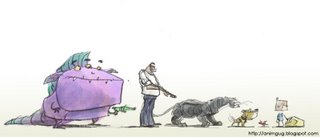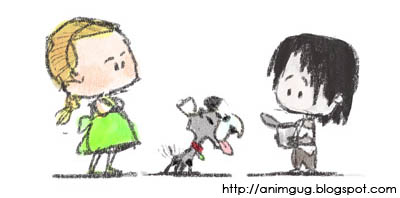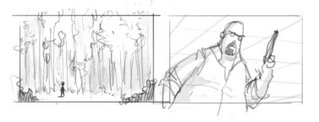As promised, here are some attempts of exploring environment ideas for my short. The first one was supposed to be a quick exploration sketch, but got out of hand and ended up taking a couple of hours. I still like the result though... The other 3 were done very quickly. Hope you like.
All in Photoshop.

Sunday, November 26, 2006
Environment concept sketches
Saturday, November 25, 2006
Infinite Options Paralysis
Part of the difficulty with making your own short film (or any major creative project, for that matter), is that anything is possible. Think about it: ANYTHING.
So, I hear you ask - isn't that the fun part? Well sort of, but here's the problem: imagine one day someone comes to you and says, you know what - for the next 5 years, you can do anything you want. No limits at all, not even physical limits. Wanna go and live on the sun for 2 months? Go ahead. It's possible.
What do you do?
You see the difficulty? There are just too many great options. No matter what you come up with, there's something even MORE wonderful that you're missing out on. For me, this can be a paralyzing thought.
One of the symptoms of this "infinite options paralysis" is going in one direction for a while, then changing your mind, taking a different route, then changing your mind again, and so on - until you get completely confused about where the hell you're going and why. I've seen it happen to others, and I've done it myself. In fact, I'm doing it right now... I'm trying to figure out if I should stay with my latest idea, or go back to the original silly animation gag idea (the one with the purple alien), which is far easier for me to make. So far I'm leaning towards the gag - perhaps using it as as an experiment before going on to the more serious project.
Hmmm....this was supposed to be about environment concept art, but ended up with too many words. I'll post the sketches next time. Stay tuned...
Thursday, November 23, 2006
Recommended blog: Temple of the Seven Golden Camels
Just after I published my "symbolism in staging" post, I got to read an excellent post by storyboard artist Mark Kennedy, about character introductions. I think some of what he writes there is strongly related to the subject of symbolism, particularly the part about Disney's Cruella de Vil.
Anyway, this is an excellent opportunity to recommend this remarkable blog. Mark is very active, writing his own ideas as well as uploading tons of reference and instructional material from master draftsmen. He presents interesting topics in story development, design, composition, and more. If you're at all interested in any aspect of storyboarding, this is a blog for you:
Temple of the Seven Golden Camels
Find other recommendations under the label "hot links" (or click here). All recommended posts appear on the side bar to your right. Check them out!
Tuesday, November 21, 2006
Labeled!
Good news guys! I've gone through my blog and labeled all my posts. You can see the full list of labels (sorted by frequency) on the side banner on your right. Click a label, and you get all the posts under that label. Isn't that cool? :)
Saturday, November 18, 2006
Symbolism in staging - 1
For several months now, I’ve been spending a lot of my time at work storyboarding. Fortunately, my boss is an excellent storyboard artist, and I got to learn a lot from his comments on my work.
One of the interesting things he introduced me to, was the use of visual symbolism. What does that mean? Well, it means using composition to visually hint the audience about the characters and their relationships.
Yeah yeah, we know
Yes, we’re all familiar with the classic tricks of the trade: a small character in a huge background conveys the character feeling alone and insignificant, an up shot angle makes the character feel powerful and intimidating, and so on.
However, using tricks is different than understanding the profound ideas they represent. Visual symbolism is a strong communication tool that can be used in almost every shot, not just in special predefined cases.
Consider the following situation: two characters confront a third character - say, two students ask their professor to postpone a test. The sketch bellow shows two ways of staging the conversation:

Get in shape
First, let’s look at the silhouette.
 Notice that in picture B, there are two distinct shapes: “students shape” and “professor shape”. This visually communicates to the viewer that in this particular situation, the students are grouped together against the professor. Picture A says “Mike, Jane, professor”; picture B says “students, professor”.
Notice that in picture B, there are two distinct shapes: “students shape” and “professor shape”. This visually communicates to the viewer that in this particular situation, the students are grouped together against the professor. Picture A says “Mike, Jane, professor”; picture B says “students, professor”. Divide and conquer
Next, let’s have a look at the way the characters divide the screen space:

In picture A the screen is divided to thirds. The characters seem to “share” the screen, which makes the conversation feel more friendly. We want to suggest confrontation, so in staging B, the two “groups” are placed on either side of an imaginary middle line. This visually communicates “they’re on one side, he’s on the other side” – in other words, confrontation.

Here, the students are still silhouetted together, but now the characters don’t cut the screen in half. While we still have two “groups”, I don’t think this feels as confrontational as the original.
Made you look!
Picture A is confusing to the audience: who’s the main character? Where should we focus our attention? Notice how picture B creates an area of interest around the students’ faces. Being in the front, the guy on the left becomes the obvious star of this particularly shot. Try to look at any other area of the shot, and your eyes get almost forced into looking at him.
All this doesn’t mean that picture A is “bad staging” and must never to be used. For example, if we had a situation where three friends who got lost are trying to figure out where to go next - this shot could be perfect! It suggests exactly friendship, individual opinions, and confusion. Staging B, as we’ve seen, communicates confrontation and hierarchy. The two sketches tell us two very different stories, with nothing but pure staging – no poses, text, or facial expressions!
Friday, November 17, 2006
Saturday, November 11, 2006
A journey begins...

This here is the rather silly beginning of a short film I'm currently working on. It started out, as animation shorts sometimes do, with a need to beef up my portfolio. So I cooked up an idea involving a lots of different creatures: kids, grown ups, birds, 4 legged animals, huge purple aliens - it had everything! The story itself was nothing fancy, just a silly gag - but it provided a fair excuse for lots of fun animation. So, as long as I wasn't trying to sell it as the story of the century, I figured it'll do the work.
Anyway, soon after drawing the character study above, the idea kind of took off and evolved into a real story. The new story has only a few characters and, unfortunatelly, no purple aliens. On the other hand, it does have meaning and honesty and drama. Can't win 'em all, I guess...
As a lesson from past experiences, I've decided this is not going to be a "project" - it's going to be a hobby. So I'm kind of playing around with it. I don't know if and when it will be finished, and I don't care. We'll just see what happens.
This blog is probably going to become a bit of a project blog - probably more than half the posts are going to be short-related. Hope you guys enjoy the ride; I certainly do.






